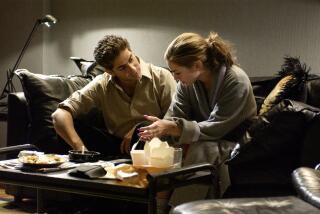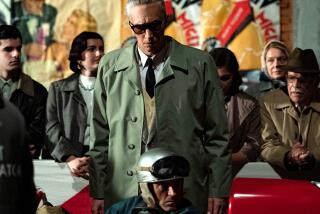Racing Toward a Miracle : Italy’s Nannini Making a Steady Recovery From Helicopter Crash That Severed an Arm
- Share via
IMOLA, Italy — The hand is not totally inert, although even an untrained eye can recognize the signs of atrophy. At best, it resembles a branch that may or may not have been grafted in time, the fingers withered and slightly shrunken.
With great effort, 31-year-old Italian Formula One driver Alessandro Nannini can produce a barely perceptible twitch in his fingertips. He explains that the circulation is sufficient, and that the nerves are growing back at a rate of a millimeter a day. Too slow for a man used to tearing along the track at more than 160 m.p.h.
“I still can’t feel anything above the wrist,” he says, pinching at the base of his thumb to illustrate. “There’s no (sensitivity).”
It is more than six months since Nannini’s right forearm was severed in a helicopter accident near his Siena home, and seven since last year’s Grand Prix in Jerez, Spain, Nannini’s last race. Today, Nannini has come to the Benetton trailer in the paddock of the Imola track to wish his former racing team luck during the time trials for the next day’s Grand Prix. It is his first visit to a race course since the accident.
“It’s strange to be here as a visitor,” says Nannini, who finished third at Imola the past two years. “The scene is still the same, the same crowds, the same chaos. It made me happy when I heard the sound of motors revving. I heard it while we were walking up from the parking lot. With that, and the smell of the exhaust, and the rain, it makes me realize how much I miss all of this.”
Alessandro Nannini was not Italy’s most successful driver, but he was and remains the country’s favorite. He is the youngest of three children in a widely known Siena family. Nannini’s father runs the family’s industrial bakery best known for its traditional Siennese panforte dessert, and his older sister Gianna is the popular rock star who sang the “Un Estate Italiana” theme song for last summer’s Italia ’90 Soccer World Cup.
Alessandro made his Formula One debut in 1986 with the Minardi team after having raced go-karts, motorcycles, and rally cars. On the track, he won hearts with his all-out, fearless style. In person, he earned respect for his honesty, and his well-honed Tuscan wit.
“What was I thinking?” he said after the 1989 trials at Hockenheim, Germany, miraculously unscathed after he and his Benetton car had flown off the course, spun through the air, and crashed into a guardrail.
“Once I realized that I’d left the ground, I said to myself, ‘Well, you’ve got to come down sometime.’ I didn’t recall hearing that they’d annulled the law of gravity.”
Last Oct. 12, on its maiden voyage from Florence’s Peretola airport, Alessandro’s brand-new French ‘Ecureuil’ helicopter crashed in a field a few hundred yards from the Nannini family’s Belriguardo villa. Nannini had wanted to show his “new toy” to his parents before leaving for Tokyo, where he had won his first Grand Prix race the previous year.
A farmer working in a nearby vineyard said that the aircraft touched down, shot back up 25 yards into the air, then plummeted to the ground. As were the pilot and his two friends on board, Nannini was hurled out of the cabin. During his fall, the helicopter’s rotor blade cut off his right arm just below the elbow.
Nannini’s family arrived on the scene at 2:30 p.m., a few minutes after the crash. They found him still conscious, screaming: “The hand! The hand! Give me back my hand!”
Alessandro’s wife, Paola, fainted. His father, who also had raced cars in his youth, tied his belt around Alessandro’s arm to stop the bleeding, then searched for, and found, his son’s severed arm among the wreckage.
With his forearm packed in a refrigerated aluminum container, Italy’s most popular race driver was taken by ambulance to the Tuscan Trauma Center in Florence. The waiting room and lobby were packed with friends, family, and journalists. A throng of fans crowded outside in the parking lot. At 6 p.m., Nannini went into surgery. He came out at 4 in the morning.
The accident and tragedy echoed far beyond the Formula One circuit. Italians who had never followed the sport were moved by the story and sight of the Nannini family pulling together to confront their tragedy. While Alessandro’s parents, brother, and close friends paced in the waiting room--their anxious vigil lasted nearly 48 hours--the country suffered along with them.
In the recovery room, Alessandro slipped into and out of consciousness.
“I won’t race again,” a nurse heard him murmur. “I’ll go on vacation.”
The day after the accident, Nannini’s sister Gianna arrived from Berlin, interrupting a European tour. For once out of patience, she shoved past the hundreds of teen-age fans mobbing the hospital entrance. Alessandro is her favorite brother, and her only thought was to reach him.
“Knock it off,” she told him, when he started to moan about the pain. “It happened to me as well. Remember when I lost two fingers in the dough kneader? It hurts for a while. And then it goes away.”
The day after the accident, Carlo Bufalini, the surgeon who had operated on Nannini, offered his first prognosis.
“It was a more difficult operation than we’d anticipated,” he said, explaining how his surgery team had painstakingly reattached Nannini’s arm, in some areas reconstructing the driver’s torn muscles, blood vessels, and nerves.
“Unfortunately, it was not a clean cut,” the doctor said. “The arm was literally ripped apart. There was a lot of reconstruction to do. Alessandro is out of danger. He can go back to being a normal young man, and do all the things that normal young men do. I think it will be very hard for him to return to the Formula One. It will be enough if he can drive a passenger car.”
Here at Imola, with his wife at the wheel, it takes Alessandro nearly an hour to drive through the traffic that separates their hotel from the race track, a distance of a little more than a mile.
It takes him nearly as long to walk the 150 yards from the VIP parking lot to the Benetton trailer in the paddock. Everyone wants to say hello. Everyone wants to pat him on the back. Every three steps, someone stops him to embrace him. He wears a synthetic lambskin mitt to protect the injured hand from the unusually cold rain.
“All these people,” he says, grinning. “It’s not like I won the world championship or something.”
At the Benetton trailer, he finds Nelson Piquet, his former teammate, and Roberto Moreno, the Brazilian driver who has replaced him this year. He has to be coaxed to visit the team in the pits.
“I didn’t want to be in the way,” he says. “During the trials, and during the race, it’s best to leave the drivers and the mechanics alone. They’ve got enough to do.”
Nannini has had two more operations since the emergency surgery in October. He spends two weeks each month outside of Vienna, undergoing physical therapy with Willy Dungl, the Austrian “wizard” who helped former Formula One world champion Niki Lauda return to racing after he was critically burned in a crash in 1976.
Nannini’s other time is divided between his family and his public relations job with Ford Motor Co. A series of television commercials Nannini filmed for Ford last year, before the accident, have returned to the airwaves.
“They asked me if I had any objections,” he says. “I thought it was a little strange. But I guess they realize that, for the moment, I’m even more marketable now than I was before the accident.”
His face is pale and lined, a face that tragedy has aged well beyond its 31 years. Speaking softly, Nannini tells how Ford is building a special car for him, with automatic transmission, with a spinner knob on the steering wheel, and with all other controls on the left side. He confesses that he has even driven a passenger car, on occasion, at night outside his home.
“At least I won’t need for Paola to drive me every time I want to go somewhere,” he says. “But there’s a big difference between driving a passenger car, and driving a Formula One race car.”
A crowd has formed outside the trailer. Standing beneath a steady rain, people jostle to catch a glimpse of Nannini. Inside, scores of photographers elbow for shooting room. Everywhere he goes, the questions are the same. “How’s the hand? When will you come back to race? September? October?”
“I never said I’d be back at any specific time,” he says, his smile fading as he slips the injured hand back into the white mitt. “I said that I’d try to come back.
“The muscles in my forearm have just come alive. For the muscles in my hand, it could take two weeks, or it could take six months. In a few months, my doctors will be able to tell me whether it’s possible. But don’t forget, we’re talking about a miracle here.”
He rises to go. The Benetton team has asked him to watch tomorrow’s race from the pits. Italy’s state-owned RAI-TV has invited him to do color during its telecast. But Alessandro declines, saying that he would prefer to watch the race on television in his hotel, or in his home. He doesn’t want to be a hanger-on. He doesn’t want to live on past laurels. He doesn’t want sympathy.
“Of course I’d like to drive again,” he confesses on leaving. “I’d like to compete for the world championship. But just being here, being able to face the best and the worst, is a victory. In a way, I won my own world championship in the months after the accident.”
More to Read
Go beyond the scoreboard
Get the latest on L.A.'s teams in the daily Sports Report newsletter.
You may occasionally receive promotional content from the Los Angeles Times.










